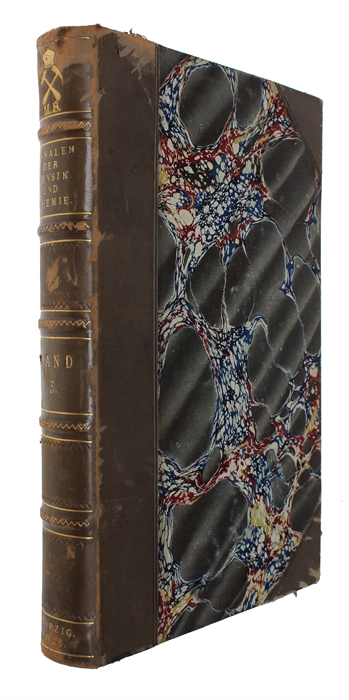FRESNEL, AUGUSTIN.
Ueber das Licht (i.e. French: "Sur la Lumière").
Leipzig, Ambrosius Barth, 1825.
8vo. In contemporary half calf with five raised bands with gilt lettering to spine. In "Annalen der Physik und Chemie", 1825, band 3. Entire volume offered. Stamps to verso of title-page and verso of plates. Wear to extremities, especially upper part of spine. Internally fine and clean. (Fresnel:) 89-128; 303-328 pp. (Entire volume:) 10, 476 pp. + 3 plates.
First German translation of Fresnel’s landmark work “Sur la Lumière" from 1822. Here Fresnel established the scientific basis for the wave theory of light and gave the theoretical framework for explaining, in the context of his theory of the transversal nature of lightwaves, the phenomena of double refraction, refraction, dispersion, polarization, interference, diffraction patterns, diffraction fringes as light spreads around objects, etc. He developed mathematically the hypothesis of the wave nature of light and he demonstrates its conformity with experience. His study of light was a dynamic interplay between theory and observation, between mathematics and experiment. - "From the point of view of method, his investigations extended from the manual operations of the laboratory to the most abstract mathematical analyses. Few physicists since Newton had been so versatile."(Silliman in "Historical Studies in the Physical Sciences", vol. 4, p. 155.). "The wave-thory at this time was still encumbered with difficulties. Diffraction was not satisfactorily explained; for polarization no explanation of any kind was forthcoming; the Huygenian construction appeared to require two different luminiferous media within double refracting bodies; and the universality of that construction had been impugned by Brewster's discovery of biaxial crystals. The upholders of the emission theory, emboldened by the success of Laplace's theory of double refraction, thought the time ripe for their final triunph; and as a step to this, in March 1817 they proposed Diffration as the subject of the Academy's prize for 1818. Their expectation was disappointed; and the successful memoir afforded the first of a series of reverses of which, in the short space of seven years, the corpuscular theory was completely owerthrown. The author was Augustin Fresnel..."(Whittaker "A History of the Theories of Aether & Electricity", vol. 1, p.107 ff.). "This concept of transverse waves met with the greatest hostility from the scientists of the day, who could not imagine an extremely fluid and rarified ether which at the same time possessed the mechanical properties of a rigid body. Even Arago admitted that he could not follow the exuberant engineer in his ideas. ButFresnel was convinced that at last he had the key to many mysteries, and with his model of waves he gave a full clarification of the phenomena of polarization. With insuperable precision he explained a long series of extremely complicated experiments, such as those of chromatic polarization that Arago himself had discovered by chance in 1811, and which the followers of Newton could not explain in spite of all their efforts. Following this line Fresnel reached the synthesis which is his masterpiece....we must recall the final interpretation that he gave of the famous phenomenon of partial reflection by transparent surfaces, that simple phenomenon which until then had puzzled Grimaldi, Newton, and Huygens, and which in Malus's experiments had unexpectedly acquired a special importencee as it had been compared to the great mystery of double refraction."(Ronchi "The Nature of Light", p. 255 ff.).
Order-nr.: 59821


